QuestionQUESTION: Hi Jennifer, i live in the Scotland and i recently did some research on torch corals and i read that they get brown jelly disease. They are a nice looking coral and went ahead and bought one from a website. Probably not the best option but my Fish store hardly gets much hard corals in. The dealer sent an email telling me that the coral would be well packed and kept warm as the temperature in scotland was minus 2 when it was due to get delivered. they postponed to a later date to let the weather get warmer which it did. it was delivered friday and i did the proper acclimitision procedure all was fine when added to the substrate in the quarantine tank, the coral opened up superbly. The next morning it was falling apart and was all slimy, my hermits were having a go at it and i had look at it and it was smelly. What could have caused this and how do i go about correcting this in future as i want to keep these beautiful corals in my reeftank!
Many Thanks
ANSWER: Hi Paul. I am so sorry to hear of your trouble! Torch corals are not a very hard coral to keep. They do, as most corals, need water of the highest quality and any amount of ammonia or nitrite will cause a rapid decay. Nitrate should be as close to zero as possible but I have seen them do okay in a tank with a nitrate reading of up to 10 ppm. Temperature should be around 80 degrees F.(27 deg. C.) They do not like intense metal halide lighting and do much better in moderate lighting. The sudden exposure to intense lighting, especially after days of less-than-adequate light can cause light induced shock that can seriously harm coral tissue. It may result in either the rapid death of the colony or the expulsion of the symbiotic algae in their tissues. All newly purchased corals, especially from an unseen source, should be placed in a low light area of the tank and gradually weaned up to brighter illumination. To loose a coral like this overnight my thoughts would be a water quality problem or an incompatible coral some where in your tank. While most people focus on the placement of a coral to give it all it needs very few realize that corals compete for space in our tanks just as they would out on a reef. Some species of corals can not be kept together in the same tank at all due to the chemical warfare agents they produce in order to protect their spot on the reef. All of this spills over into your tank and I have seen many corals fall victim very quickly to the chemicals produced by other neighboring corals. Some corals also can put out very long sweeper tentacles during the period of darkness that if touch another coral will cause massive tissue decay almost upon contact. Most coral diseases are more drawn out and do not occur in one night. Generally showing signs of sickness before the actual decay starts. Could your hermit crabs have been the culprits? These corals do not tolerate hermit crabs walking all over them and will close up when tread upon. Some hermit crabs will eat anything and everything edible and most are not a good idea to keep with many different kinds of corals. I can not tell you exactly what happened to your coral all I can do is point you in a direction to start to look for answers. You have to be the detective to get to the bottom of this loss. Perhaps the most important outcome of an unexpected mortality is that you can assess the cause and nature of the event. I do not think of life as simply replaceable, and the financial loss is not the greatest disappointment. There is a great deal that can be learned from such a happening, especially how to avoid repeating the same mistakes. For me any time a bad event happens it gives me an opportunity to learn and learning is what life is all about isn't it?
---------- FOLLOW-UP ----------
QUESTION: Hi again, my hermits must have pulled the coral out of the sand this must have been threw the night as it was open during the day thats when i thought that it was dead. But i have since done my chemical checks, nitrite, nitrate PH etc the nitrate was pretty high, i didnt expect it to be so high as i do a lot of partial water changes and fresh water top ups. The Nitrate must have been the cause. How do i get the nitrate to go down again. I am about to do my monthly %25 water change what else apart from over feeding can be done to get it down?
Can i also ask if you know about the false gramma. I have one and its color seems to be fading slightly. Could this be poor diet, illness or just what happens over time. He seems healthy enough
Many Thanks
AnswerHello again. Depending on how high your nitrates were they can cause a quick demise to a coral but I would guess that your hermit crabs had more of a role in the passing of the coral than the nitrate(unless your nitrate was extremely high). Usually really high nitrate will cause a slower wasting away condition than an over night loss. Most hermit crabs are not really considered reef safe as individual personalities can result in even the smallest and seemingly harmless hermits turning into coral eating maniacs. The best way to reduce nitrates is by doing more frequent partial water changes. While the general rule is to do a 25% partial once a month, every tank has its own personality and some may need to be cleaned more frequently than others. I usually recommend a 20% partial at least every two weeks as a normal maintenance procedure. This is only after you get your nitrate to come down. You may have to do a 10% partial every few days until the nitrate falls within a healthy range. After that point test it often and when it starts to go up you will need to do another partial. This will give you a good gauge as to how often a partial should be done on your tank. Overstocking, overfeeding and not enough protein skimming or inadequate filtration are all contributing factors to a high nitrate in your tank. However, nitrate will eventually build up in any system where there is not a particular filter(such as a refugium or a denitrating filter) in place to keep the nitrate down. It is a result of all the normal processes going on in your tank and can be expected to remain in there for as long as you have your tank. You may want to also check your phosphate level as this in high amounts will also not be tolerated too well by corals and usually if the nitrate is very high the phosphate will follow closely behind. Phosphate can be removed much in the same manner as nitrate. You can also try adding some decorative macro algae to your system. These will take up a great deal of the nutrients in your water and cause a much better living condition for all the inhabitants of your tank.
Your false gramma or pseudochromis may be changing color due to the unfavorable nitrate level in the tank as well. Poor nutrition and old age as well as illness can all cause the same paling of color in any fish. These fish have a general life expectancy of 3-4 years so if you have had him that long he may just be old. If not then chances are when you get your nitrate under control his color will come back. Feeding should consist of a good variety of frozen meaty marine foods such as mysis shrimp, brine shrimp, squid, clam, cyclopse, and bits of krill or prawn. I do not recommend feeding dried prepared foods to marine fish. While these are much more convenient to feed they do not offer the complete nutrition that a wide variety of frozen meaty foods can. Using an nutritional additive to the foods can also improve the fishes overall health as well.

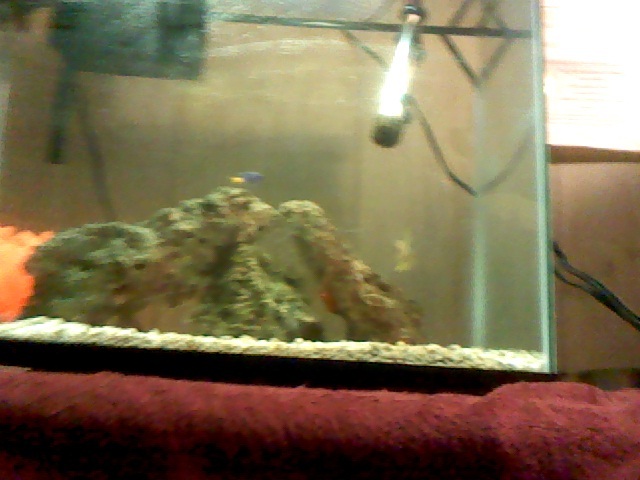 aqurium light
Question
my tank
hello, I have a 14 gallon aquarium tha
aqurium light
Question
my tank
hello, I have a 14 gallon aquarium tha
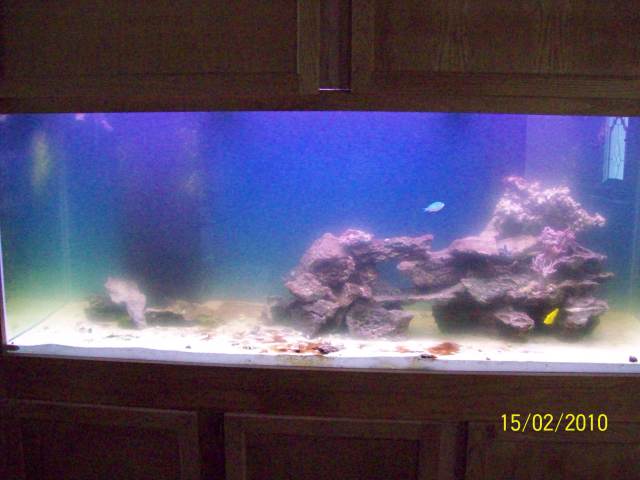 Cloudy reef tank
QuestionTank pic
QUESTION: I set up a new 250 ga
Cloudy reef tank
QuestionTank pic
QUESTION: I set up a new 250 ga
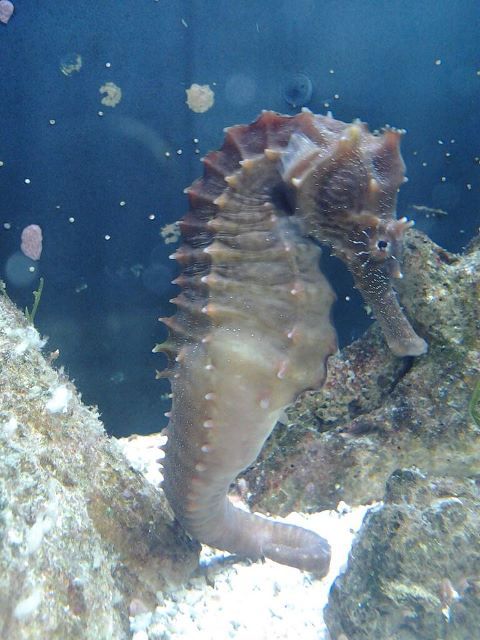 sick seahorse
Question
sick seahorse
Hi Marcus...not real sure
sick seahorse
Question
sick seahorse
Hi Marcus...not real sure
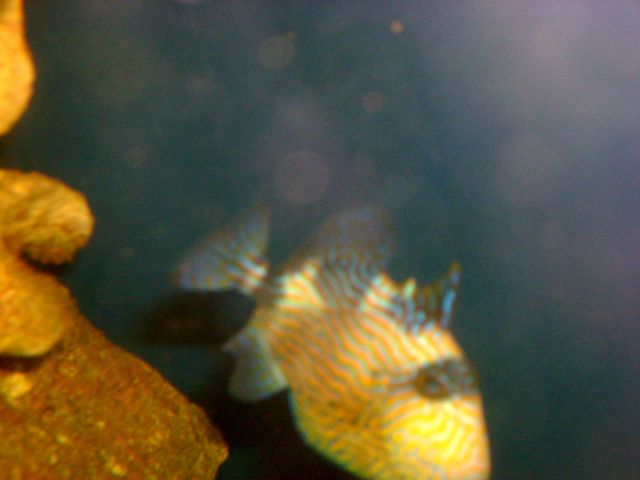 blue line trigger fish
Question
blueline triggerfish
is there any way to tell
blue line trigger fish
Question
blueline triggerfish
is there any way to tell
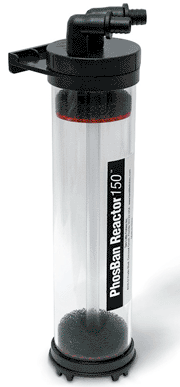 Red Slime
QuestionMy tank was cycled , beautiful, stocked, up & r
Red Slime
QuestionMy tank was cycled , beautiful, stocked, up & r